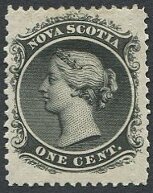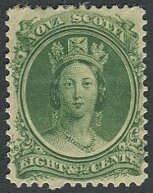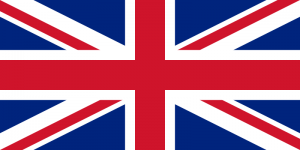
Nova Scotia
Quick reference
General issues: British colony/Self government 1851-1868
Country name on general issues: Nova Scotia
Currency: 1 Shilling = 12 Pence 1851-1869, 1 Dollar = 100 Cents 1860-1868
Population: 322 000 in 1861
Political history Nova Scotia
Exploration and settlement
Nova Scotia is located in North America and is one of the Maritime Provinces of modern day Canada. Prior to colonization, Nova Scotia was inhabited by the Amerindian Mi’kmaq or Micmac people – a people found also in the other Maritime Provinces. The first Europeans to have temporarily settled in Nova Scotia may have been the Norsemen around 1 000 AD. The first documented exploration of Nova Scotia dates from 1497, when the Italian explorer Giovanni Caboto – also referred to by his English name of John Cabot – explored the Atlantic Coast of Canada. The first permanent settlement was established by the French, in 1605, at Port-Royal – the current Annapolis Royal. Port-Royal was the first European settlement in Canada and became the capital of the French colony of Acadia that roughly consisted of today’s Maritime Provinces.
From French to British rule
Throughout the 17th and 18th centuries, Nova Scotia would be fought over by the French and the British – the British being firmly established south of Nova Scotia in the Thirteen Colonies – the founding colonies of the United States. Eventually, the British gained the upper hand. Mainland Nova Scotia was ceded to the British in 1713. In 1763, the French ceded all of their possessions, in what today constitutes Canada, to the British – with the exception of the small islands of Saint Pierre & Miquelon that have remained a French possession until today. The British, subsequently, attached Acadia to Nova Scotia.
From British colony to province of Canada
In the following decades, parts of Nova Scotia would be established as separate colonies. In 1769, Prince Edward Island became a separate colony and in 1784 Cape Breton and New Brunswick were separated from Nova Scotia. Cape Breton was reattached to Nova Scotia in 1820 and thus, Nova Scotia was established as we know it today. The last conflict over the sovereignty of Nova Scotia was the War of 1812 with the United States – the war ended in the status quo ante bellum. Nova Scotia gained self government in 1848 – the first of the British colonies to do so. In 1867, Nova Scotia was one of the founding members of the federation of Canada, and Nova Scotia has been a province of Canada since then.
Economics
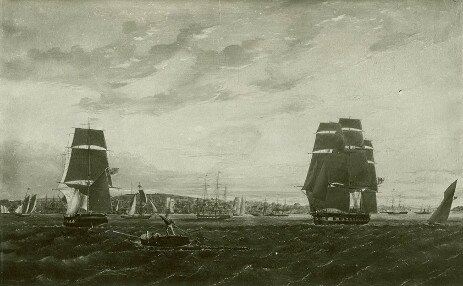
An artist’s impression of Halifax harbor in 1850 – a painting by John O’Brien.
Economically, in the 19th century, fishing and forestry were the main activities. At the time, Nova Scotia also had a significant shipbuilding industry – wooden ships. Towards the end of the 19th century mining was developed. These traditional sectors of the economy have declined in the 20th century – tourism and other service industries have become the most important components of the economy.
Demographics
The population of Nova Scotia would seem to reflect its history. The first Europeans to settle Nova Scotia in significant numbers were the French. When the British had taken over mainland Nova Scotia, the French settlers were, in 1755, expelled – some to return after all of Acadia had become British in 1763. After the French were expelled, British settlers from New England were invited to come to Nova Scotia – settlers known as the New England Planters. A next wave of British settlers followed in 1783, after the War of Independence of the United States – settlers known as the Loyalists, since they had stayed loyal to Britain during the War of Independence. In the 19th century the main flow of immigrants came from Ireland and Scotland. Thus, 32% of today’s population identifies itself as Scottish, 32% as English, 22% as Irish and 18% as French – French is spoken by the majority of the population in some of the southern counties of Nova Scotia. The indigenous Mi’kmaq, currently, account for just over 5% of the population.
Postal history Nova Scotia
Nova Scotia issued its first stamps in 1851. The Nova Scotia stamp production is small but exquisite – reason enough to discuss the design of the issues in some more detail. Two sets were issued. The first set consists of two distinct designs, the second set of three designs.
The first set was issued between 1851 and 1857 and printed by Perkins, Bacon and Co. in London:
-
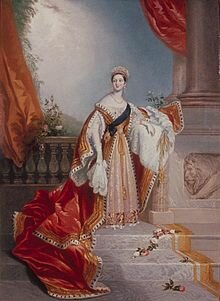
1837 – Queen Victoria portrayed by Alfred Edward Chalon.
The first design of this set shows a portrait of Queen Victoria after a painting by Alfred Edward Chalon. The painting was made at the occasion of Queen Victoria’s first public appearance in the House of Lords in 1837. The design is one of a number of designs known as the ‘Chalon Heads’. Chalon Heads have also been issued by Canada, New Brunswick and Prince Edward Island. Further afield, Chalon Heads have been issued by the Bahamas and Grenada in the Caribbean, by Natal in southern Africa and by New Zealand, Queensland and Tasmania in Oceania. The first Chalon Heads were issued by Canada in 1851 and the last by Prince Edward Island in 1870. After that, the Chalon Head has appeared on the commemorative Diamond Jubilee series, issued by Canada in 1897. The design of the Nova Scotia issues is unique – the Queen is portrayed in a diamond shaped frame on a square shaped stamp. To my knowledge the Chalon Heads are the only definitives issued with an en face portrait of Queen Victoria.
- The second design in this set shows the British Crown and the four heraldic flowers of the constituent parts of Great Britain. Stamps of similar designs were issued by New Brunswick and Newfoundland. The Nova Scotia issues are in a diamond shape as were the New Brunswick issues – the Newfoundland issues were printed as squares.
Intriguing as the stamps of this first issue may be, the very high catalog values are probably prohibitive for most worldwide collectors.
The second set was issued between 1860 and 1863 and printed by the American Bank Note Company in New York:
-
The design for the lower denominations is a powerful portrait of Queen Victoria engraved by Alfred Jones based on an earlier design by Charles Henry Jeens. The portrait is also used for the first two sets issued by the Dominion of Canada – known as the Large Queens and the Small Queens. On the Nova Scotia issues the Queen faces left – on the Canada issues the Queen faces right. It is interesting to note: the Nova Scotia issues were printed by the American Bank Note Company in New York, while the Canadian issues were printed by the British American Bank Note Company in Montreal and Ottawa – founded in 1866 by former employees of the American Bank Note Company. One might suspect a connection.
- The other two designs used for the second set are, again, Chalon Heads – now in the more common rectangular shape. The difference between the two designs lies in the frame.
Fortunately the stamps of this second set are more affordable. The stamps of Nova Scotia were superseded by the issues of the Dominion of Canada in 1868.
Album pages
← Previous page: Canadian Provinces - NewfoundlandNext page: Canadian Provinces - Prince Edward Island →


